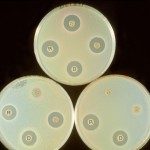Lien vers Pubmed [PMID] – 19273688
Antimicrob. Agents Chemother. 2009 05;53(5):1808-16
We report the emergence of Salmonella enterica isolates of serotype Concord (and its monophasic variant 6,7:l,v:-) producing the extended-spectrum beta-lactamases (ESBLs) SHV-12 and CTX-M-15 in France and Norway between 2001 and 2006 (43 in France and 26 in Norway). The majority of these isolates were from adopted children from Ethiopia, most of whom were healthy carriers. Several symptomatic secondary cases were found in the adoptive families and health care facilities in France. Serotype Concord isolates collected before 2003 produced SHV-12 encoded on a 340-kb conjugative plasmid of replicon IncI1. Isolates collected after 2003 produced CTX-M-15. We detected two conjugative plasmids carrying bla(CTX-M-15). One plasmid, approximately 300 kb in size, was positive for the IncHI2 replicon and the plasmid-mediated quinolone resistance gene qnrA1. The other plasmid, from one of the earliest CTX-M-15-producing isolates collected, was a fusion plasmid with IncY and IncA/C(2) replicons and was 200 kb in size. However, we showed, using Southern hybridization of I-CeuI-digested chromosomal DNA and S1 nuclease analysis of plasmid DNA, that most isolates had a bla(CTX-M-15) gene located on chromosomal DNA. Analysis of the flanking regions of the chromosomally located bla(CTX-M-15) gene by cloning revealed an ISEcp1 truncated by an intact IS26 upstream from the bla(CTX-M-15) gene and a truncated orf477 gene downstream from bla(CTX-M-15). We found regions beyond the IS26 and the orf477 genes that were derived from IncA/C(2) plasmids, suggesting the chromosomal integration of part of the bla(CTX-M-15)-carrying IncY and IncA/C(2) fusion plasmid from early CTX-M-15-producing isolates.

